Rjukan
Rjukan (Norwegian: [ˈrʉ̀ːkɑn]) is a town and the administrative centre of Tinn municipality in Telemark, Norway. It is situated in Vestfjorddalen, between Møsvatn and Lake Tinn, and got its name after Rjukan Falls west of the town. The Tinn municipality council granted township status for Rjukan in 1996. The town has 3,386 inhabitants (Jan. 2007).
Rjukan | |
|---|---|
City | |
Panorama of Rjukan town, 2015 | |
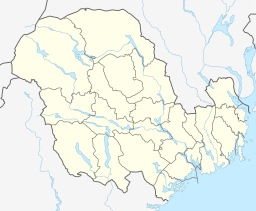 Rjukan Location in Vestfold og Telemark 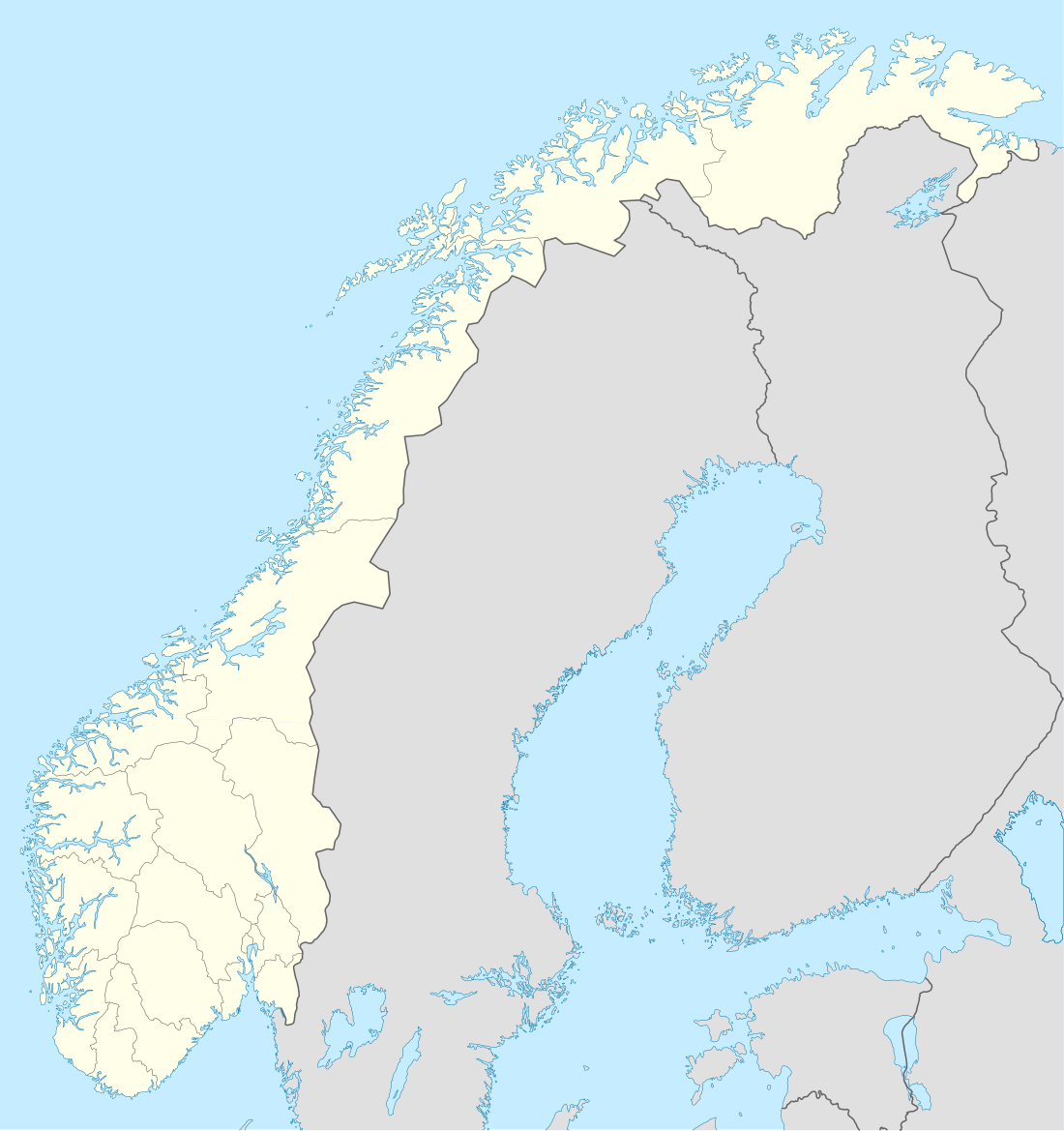 Rjukan Rjukan (Norway) | |
| Coordinates: 59°52′44″N 08°35′38″E | |
| Country | Norway |
| Region | Austlandet |
| County | Vestfold og Telemark |
| District | Aust-Telemark |
| Population (2007) | |
| • Total | 3,386 |
History
.jpg)
Rjukan was formerly a significant industrial centre in Telemark, and the town was established between 1905 and 1916, when Norsk Hydro started saltpetre (fertilizer) production there. Rjukan was chosen because Rjukan Falls, a 104-metre waterfall, provided easy means of generating large quantities of electricity. The man with the idea to use the Rjukan falls was Sam Eyde, the founder of Hydro. It is estimated that he, together with A/S Rjukanfoss (later Norsk Hydro), used about two times the national budget of Norway to build Rjukan.
Between 1907 and 1911 Norsk Hydro built what was at the time the world's largest hydro-electric power plant at Vemork near Rjukan, and in 1934 built an adjacent hydrogen plant. A by-product of hydrogen production via water electrolysis was heavy water. It was the later Nobel prize winner Odd Hassel who told Norsk Hydro that they were in fact producing heavy water. The Norsk Hydro was controlled by the Germans during [[World War II], was sabotaged twice by the Norwegian resistance movement and bombed by the allied forces.
After 1960, most of the saltpetre production in Rjukan was transferred to Norsk Hydro factories at Herøya in Porsgrunn. Some industry is still present in Rjukan, among them Scan Alloys.
Rjukan Church
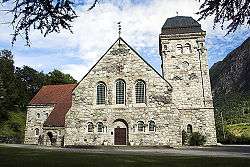
Rjukan Church (Rjukan kirke) was constructed of natural stone with a tower at the entrance to the southwest. The church was consecrated on December 21, 1915. The church was designed by the architects Carl and Jørgen Berner with a cruciform architectural floorplan. The altar image came into place in April 1917 and was painted by Bernhard Folkestad. Seven vaulted windows in the foundation wall have stained glass paintings by Torvald Moseid. [1] [2] [3] [4] [5]
Tourism
Rjukan has a long history of tourism. Tourists have come to the narrow valley for over a century. Rjukan Falls is a famous landmark in Norway, and has been portrayed by several famous artists. The area has good terrain for skiing, and the town is a good starting point for hiking on the Hardangervidda plateau. In the 1860s, Krokan by the Rjukan waterfall was Norwegian Mountain Touring Association's (DNT) first hut. After the waterfall was harnessed for hydro power production, the hut was sold. Today it is re-opened, situated by the main road from Rjukan (Tinn) to Vinje. In later years Rjukan has become famous for its ice climbing possibilities. The season is long, from November to April and the waterfalls are many and varied.
Today, the power plant at Vemork has been made into the Norwegian Industrial Workers Museum where the history of Rjukan and a history of Industrial labour is displayed, in addition to history of the war and the sabotage connected to it.
Between September and March, Rjukan lies in the shadow of the mountains and does not get sunlight. In 2013, at a cost of 5 million Norwegian kroner, large mirrors were placed on the mountainside to reflect the sun to illuminate the town square.[6]
Gallery
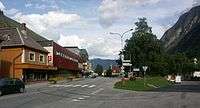 Rjukan town center, narrowly sandwiched between tall, steep slopes
Rjukan town center, narrowly sandwiched between tall, steep slopes- Map showing the position of Rjukan between lakes Møsvatn (west, upstream) and Lake Tinn (east)
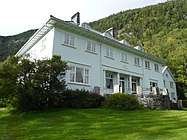 Norsk Hydro Administration Building
Norsk Hydro Administration Building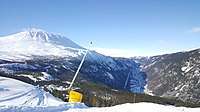 Rjukan is in constant shadow during the winter. Image taken from Gausta ski center.
Rjukan is in constant shadow during the winter. Image taken from Gausta ski center.
References
- "Rjukan kirke". Norske Kirkebygg. Retrieved December 1, 2017.
- Trond Marinus Indahl. "Carl Berner". Norsk kunstnerleksikon. Retrieved December 1, 2017.
- Anne-Berit Skaug. "Jørgen Berner". Norsk kunstnerleksikon. Retrieved December 1, 2017.
- Henning Alsvik. "Bernhard Folkestad". Norsk kunstnerleksikon. Retrieved December 1, 2017.
- Sigrid Christie. "Torvald Moseid". Norsk kunstnerleksikon. Retrieved December 1, 2017.
- Harriet Alexander. "Norwegian town places mirrors on hillsides to shine light into valley". The Daily Telegraph, 23 October 2013. Accessed: 24 October 2013.
External links
| Wikimedia Commons has media related to Rjukan. |
| Wikivoyage has a travel guide for Rjukan. |